Hello, Rabbit, he said, is that you? Let’s pretend it isn’t, said Rabbit, and see what happens- Milne

Time to hop into March!
And who better to do it than the Rabbit and his cousin Hare. In general, both are associated with the Moon, magic, luck, love, creativity, success, sensitivity, agility, spontaneity, abundance, and rebirth and, of course, fertility. In Chinese myth, it is said that the Buddha called all animals to his side before he was to leave this world, but only 12 came – the rabbit is the fourth to come bid him farewell. In Indian legend, it was said that Buddha was a hare in one of his earlier incarnations. In Christianity hares and rabbits, associated with the Goddess and unblemished white rabbits symbolizing purity, piety, and the Holy Virgin. In Judaism, the rabbit is considered an unclean animal, because “does not have a divided hoof.” In Greco-Roman myth, the hare is symbolic of romantic love, abundance, sexuality and tremendous fertility. 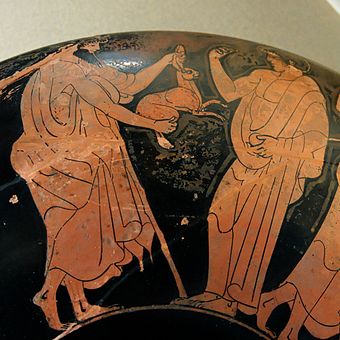
Hares were also associated with the Artemis, goddess of wild places and the hunt, and new-born hares were not to be killed but left to her protection. In Greece, the gift of a rabbit was a common love token from a man to his male or female lover. In Rome, the gift of a rabbit was intended to help a barren wife conceive. Carvings of rabbits eating grapes and figs appear on both Greek and Roman tombs, where they symbolize the transformative cycle of life, death, and rebirth. In Egyptian tradition, the rabbit is connected to the very essence of being. These mystical creatures, known throughout the world in legend, lore, and literature, are gentle leaders, pushing us toward fertile grounds, physically, mentally and spiritually. 
Even in the stars, we can see the mysticism of Rabbit.
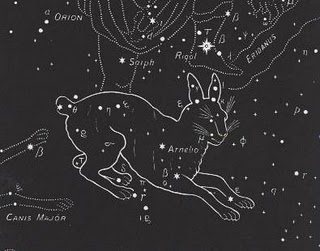
Across the night sky, the constellation Lepus is the Hare that forever eludes Orion’s hunting dogs. However, also rabbits and hares have long been associated with witches or as witches themselves in animal form and the ability to walk between the worlds and commune with the faeries.
However, also rabbits and hares have long been associated with witches or as witches themselves in animal form and the ability to walk between the worlds and commune with the faeries.
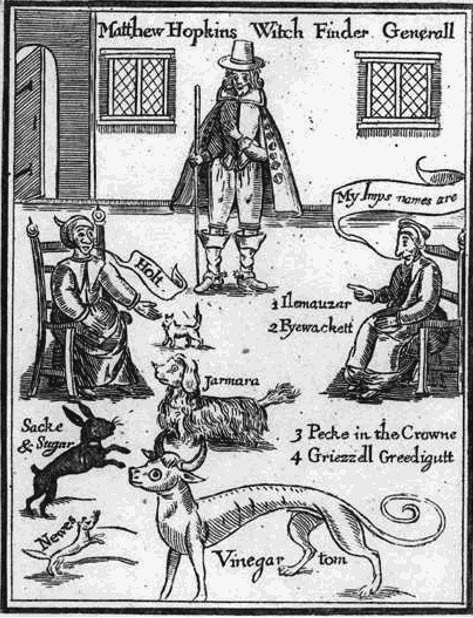
They were animal’s witches, playing the role now given to cats. Their ability to dart quickly amidst the shadows as they walk between the earthly realm and the spirit realm, often disappearing and reappearing in the blink of an eye, makes them privy to hidden knowledge and wisdom. Rabbits serve as witches’ familiars and messengers and were believed to be the form into which witches most frequently transform. The association of rabbits with witches is not limited to Europe. In China, rabbits are identified with witches, alchemy, and sorcery.
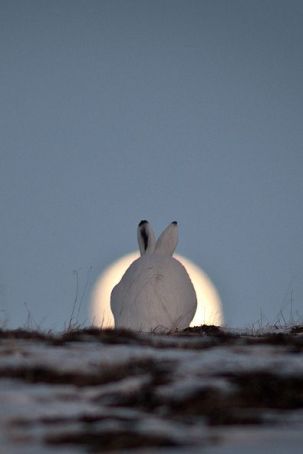
Instead of a man in the moon, China has an alchemist rabbit in the moon, endlessly grinding the elixir of immortality with his mortar and pestle, a servant of witch goddess Hsi Wang Mu.
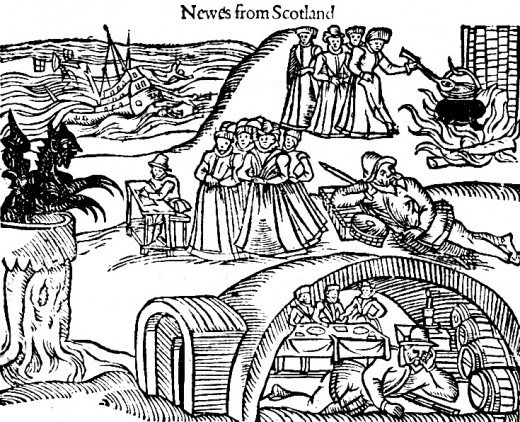
At the 16th and 17th centuries in Scotland as well as elsewhere in Europe, the Christianity we know about from history books was mainly practised by the elite. Royals and the aristocracy were the first converts, often for political reasons.
King James VI of Scotland is most well-known for commissioning the King James Bible. For this, he is celebrated by Christians in the English-speaking world to this day.
 But, many people don’t know about his role in the Scottish witch hunts. Another book was also written by the King’s own hand. Daemonologie was a handbook on demons, witchcraft, and the devil. Prior to James’ reign, witch hunts were not especially common in Scotland. James developed an interest in witchcraft that appears to have bordered on obsession. He signed a law in 1591 which made the torture of witches legal, and he is said to have attended witch trials personally. His writings on witchcraft became incredibly popular and influential. Shakespeare is said to have used Daemonologie as a source for information on the witches that feature in such plays as Macbeth.
But, many people don’t know about his role in the Scottish witch hunts. Another book was also written by the King’s own hand. Daemonologie was a handbook on demons, witchcraft, and the devil. Prior to James’ reign, witch hunts were not especially common in Scotland. James developed an interest in witchcraft that appears to have bordered on obsession. He signed a law in 1591 which made the torture of witches legal, and he is said to have attended witch trials personally. His writings on witchcraft became incredibly popular and influential. Shakespeare is said to have used Daemonologie as a source for information on the witches that feature in such plays as Macbeth.
About 75 years after James’ book, in 1662, Isobel Gowdie, a Scotswoman, apparently volunteered a detailed confession of witchcraft. She described how she and her fellow coven members transformed into hares via a magical chant. Isabel was a young housewife from Auldearn in Nairnshire who is remembered not just for being tried as a witch, but for her detailed confession. She claimed to have been in league with the Devil for fifteen years and first met him at a church in Auldearn. She claimed that her coven members could even change the shape of animals.
Rabbit witches serve as entertainment for children: in Katherine Pyle’s illustrated 1895 children’s book, The Rabbit Witch and Other Tales, a rabbit Witch in a headscarf steals naughty children; in Walter De La Mare’s children’s poem, “The Hare”, “an old witch-hare” gets spooked herself.

I remember the Hansel and Gretel story, the classic fairy tale where the Witch Hazel plays the witch who tries to cook and eat the children. Once Hazel realizes that Bugs is a rabbit, she tries to cook him instead, using a carrot as a lure.
I am asking myself is that cute little a bunny doing horrible violence to people and it does beg a question? What the hell is going on?
 Through the Easter rabbit, the Chinese zodiac sign of the rabbit, the Energizer bunny, the cereal Trix bunny, the animated Bugs Bunny, Beatrix Potter’s charming Peter Rabbit, Lewis Carroll’s “Alice in Wonderland”‘s White Rabbit, and March Hare, the phrase “Mad as a March Hare” ,” The Velveteen Rabbit” by Margery Williams, “Watership Down” by Richard Adams
Through the Easter rabbit, the Chinese zodiac sign of the rabbit, the Energizer bunny, the cereal Trix bunny, the animated Bugs Bunny, Beatrix Potter’s charming Peter Rabbit, Lewis Carroll’s “Alice in Wonderland”‘s White Rabbit, and March Hare, the phrase “Mad as a March Hare” ,” The Velveteen Rabbit” by Margery Williams, “Watership Down” by Richard Adams 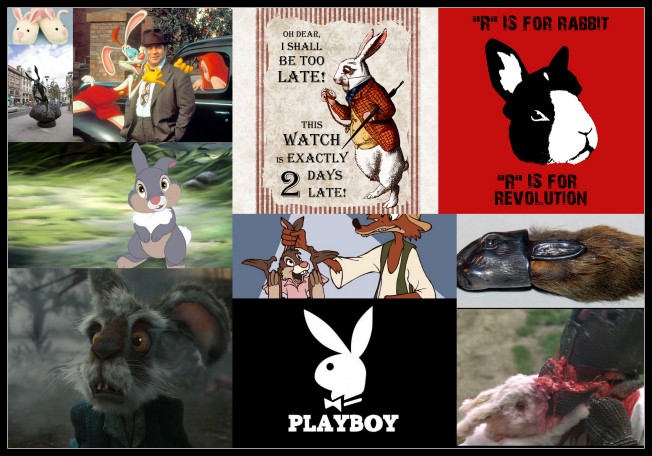 Disney’s character Thumper from “Bambi”, the African American tales of B’rer Rabbit, the animated film “Who Framed Roger Rabbit?” (with the famously sexy Jessica Rabbit), the trickster rabbit from Native American to African tales, in Monty Python’s “Holy Grail” as the famous Killer Rabbit of Caerbannog, the sexy Playboy Bunny, the rabbit’s foot for luck, the rabbit in the moon, as a witch’s familiar, bunny slippers, the American name for a Volkswagen car………………………………… the list goes on.
Disney’s character Thumper from “Bambi”, the African American tales of B’rer Rabbit, the animated film “Who Framed Roger Rabbit?” (with the famously sexy Jessica Rabbit), the trickster rabbit from Native American to African tales, in Monty Python’s “Holy Grail” as the famous Killer Rabbit of Caerbannog, the sexy Playboy Bunny, the rabbit’s foot for luck, the rabbit in the moon, as a witch’s familiar, bunny slippers, the American name for a Volkswagen car………………………………… the list goes on.
The usual imagery of the rabbit in Medieval art is that of purity and helplessness. But in medieval manuscripts, the image of the rabbit’s revenge is often used to show the cowardice or stupidity of the person illustrated.
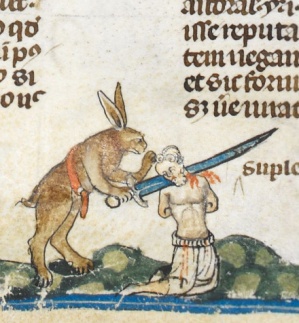

However, what about the hare? Well, the hare, called by its Latin name ‘lepus’, also has an entry in the Bestiaries and, of course, it has a Christian symbol behind it. In theory, the hare represented the man that feared God, but put his trust in him, and not in people.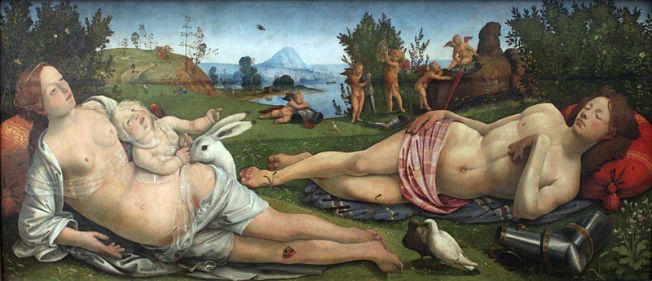
Piero di Cosimo: the image of Venus and Mars, a cupid lying on Venus clings to a white rabbit. The three hares at Paderborn Cathedral- The Hasenfenster called as hare windows in Paderborn Cathedral, in which three hares are depicted with only three ears between them, forming a triangle, can be seen as a symbol of the Trinity, and probably go back to an old symbol for the passage of time.
More hares in Albrecht Dürer’s woodcut and also Titian’s painting.
Titians’s painting the Holy Family with the Three Hares (1497) is the unusual presentation of the rabbit.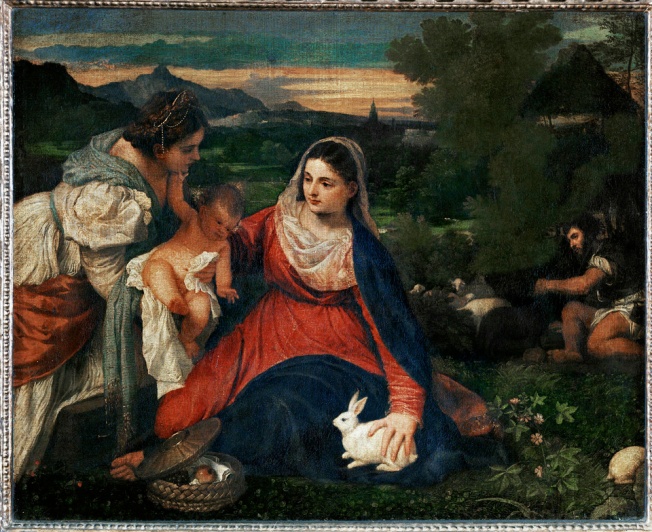 Madonna with the Infant Jesus playing with a white rabbit, together with the basket of bread and wine, a symbol of the sacrificial death of Christ, the picture may be interpreted as the resurrection of Christ after death. I find, in contrast to this painting is a tiny squashed rabbit at the base of the columns in Jan van Eyck’s Rolin Madonna symbolize “Lust”, as part of a set of references in the painting to all the Seven Deadly Sins.
Madonna with the Infant Jesus playing with a white rabbit, together with the basket of bread and wine, a symbol of the sacrificial death of Christ, the picture may be interpreted as the resurrection of Christ after death. I find, in contrast to this painting is a tiny squashed rabbit at the base of the columns in Jan van Eyck’s Rolin Madonna symbolize “Lust”, as part of a set of references in the painting to all the Seven Deadly Sins.
In non-religious art, for example in the Hunting still life with lap dog and monkey by Jan Weenix .(1714) the rabbit appears in the same context as in antiquity: as prey for the hunter, or maybe representing spring or autumn, as well as an attribute of Venus and a symbol of physical love. 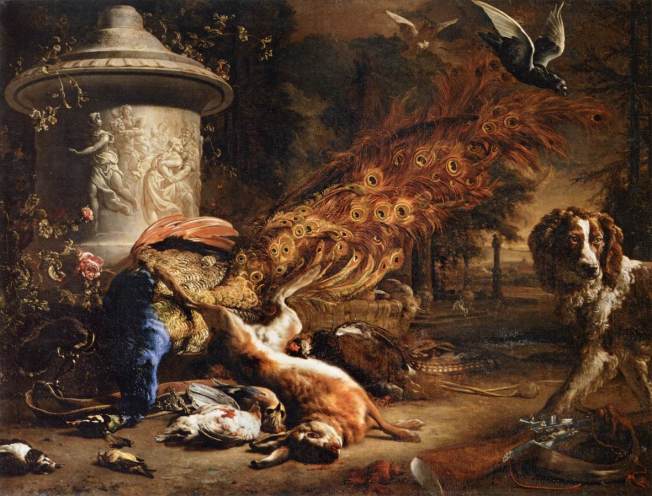 In Italian Renaissance and Baroque art, rabbits are depicted more often than hares. In an allegory on lust by Pisanello, a naked woman lies on a couch with a rabbit at her feet.
In Italian Renaissance and Baroque art, rabbits are depicted more often than hares. In an allegory on lust by Pisanello, a naked woman lies on a couch with a rabbit at her feet. 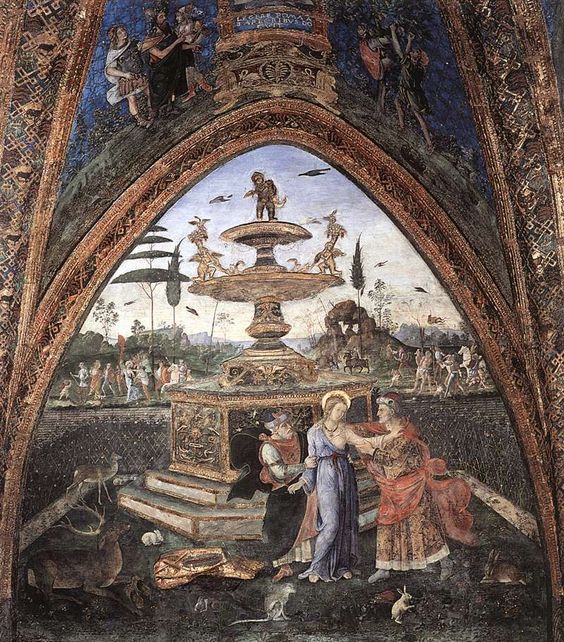 Pinturicchio’s scene of Susanna in the Bath is displayed in the Vatican’s Borgia Apartment. Here, each of the two old men is accompanied by a pair of hares or rabbits, clearly indicating wanton lust.
Pinturicchio’s scene of Susanna in the Bath is displayed in the Vatican’s Borgia Apartment. Here, each of the two old men is accompanied by a pair of hares or rabbits, clearly indicating wanton lust.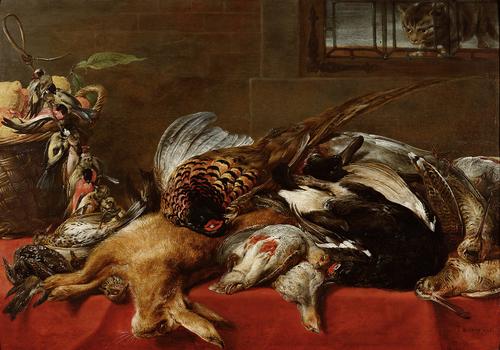 Back to still lifes painting in the Dutch Golden Age. These Flemish equivalents often included a moralizing element which was understood by their original viewers without assistance: fish and meat can allude to religious dietary precepts, fish indicating fasting while great piles of meat indicate voluptas carnis (lusts of the flesh), especially if lovers are also depicted. Rabbits and birds, perhaps in the company of carrots and other phallic symbols, were easily understood by contemporary viewers in the same sense.
Back to still lifes painting in the Dutch Golden Age. These Flemish equivalents often included a moralizing element which was understood by their original viewers without assistance: fish and meat can allude to religious dietary precepts, fish indicating fasting while great piles of meat indicate voluptas carnis (lusts of the flesh), especially if lovers are also depicted. Rabbits and birds, perhaps in the company of carrots and other phallic symbols, were easily understood by contemporary viewers in the same sense.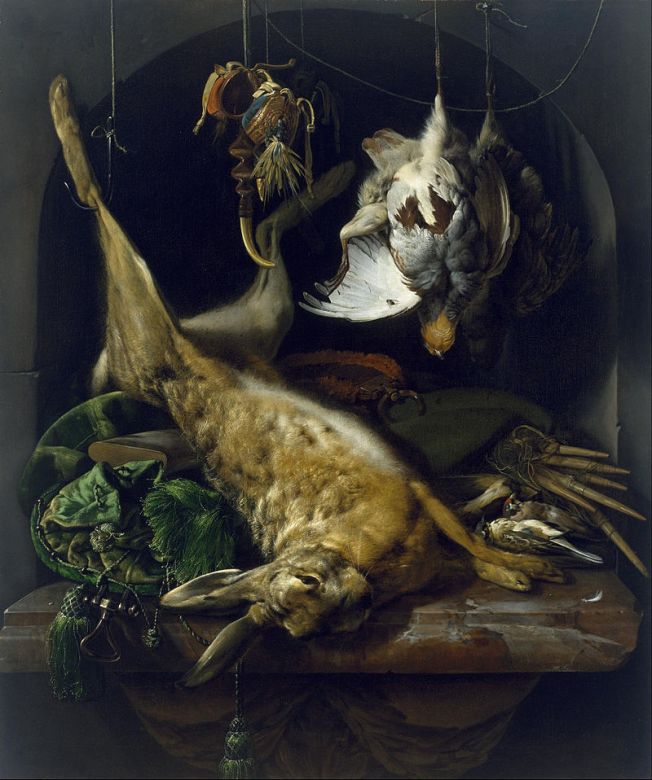 As small animals with fur, hares and rabbits allowed the artist to showcase his ability in painting this difficult material. Dead hares appear in the works of the earliest painter of still life collections of foodstuffs in a kitchen setting, Frans Snyders, and remain a common feature, very often sprawling hung up by a rear leg, in the works of Jan Fyt, Adriaen van Utrecht and many other specialists in the genre.
As small animals with fur, hares and rabbits allowed the artist to showcase his ability in painting this difficult material. Dead hares appear in the works of the earliest painter of still life collections of foodstuffs in a kitchen setting, Frans Snyders, and remain a common feature, very often sprawling hung up by a rear leg, in the works of Jan Fyt, Adriaen van Utrecht and many other specialists in the genre.
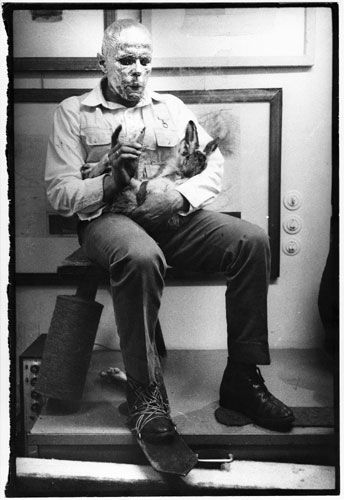
In modern art, Joseph Beuys was the artist who always finds a place for a rabbit in his works, sees it as symbolizing resurrection. In the context of his action “How to Explain Pictures to a Dead Hare”, he stated that the rabbit “…has a direct relationship to birth… For me, the rabbit is the symbol of incarnation. Because the rabbit shows in reality what man can only show in his thoughts. He buries himself, he buries himself in a depression. He incarnates himself in the earth, and that alone is important.”
The Welsh sculptor Barry Flanagan (1944-2009) was best known for his energetic bronzes of hares, which he produced throughout his career. Many have a comic element, and the length and thinness of the hare’s body are often exaggerated.
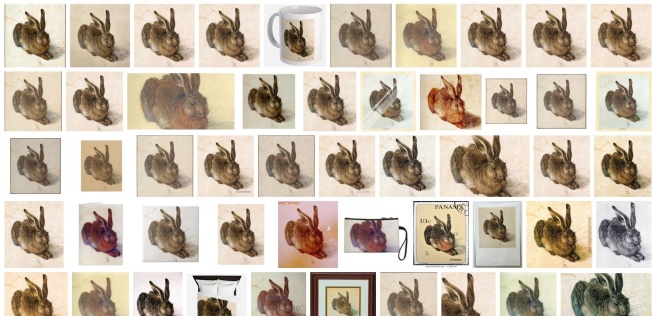 The most famous hare in the history of art is probably The Young Hare, a watercolour painting by Albrecht Dürer, now preserved in the Albertina in Vienna.
The most famous hare in the history of art is probably The Young Hare, a watercolour painting by Albrecht Dürer, now preserved in the Albertina in Vienna.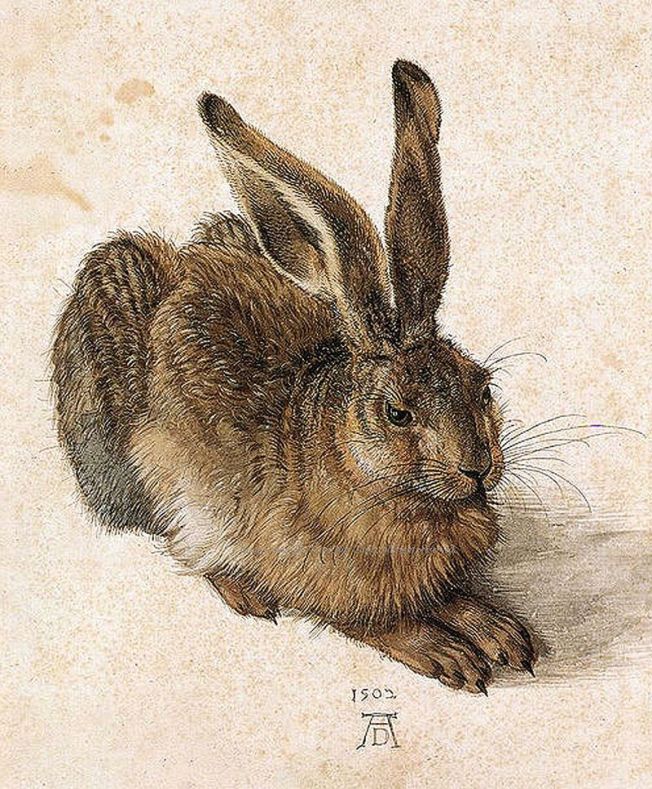 Dürer’s image is seen in the context of his other nature studies, such as his almost equally famous Meadow or his Bird Wings. He chose to paint these in watercolour or gouache, striving for the highest possible precision and “realistic” representation. This hare painting probably does not have a symbolic meaning, but it does have an exceptional reception history. A reproduction of Dürer’s hare has often been a permanent component of bourgeois living rooms in Germany.
Dürer’s image is seen in the context of his other nature studies, such as his almost equally famous Meadow or his Bird Wings. He chose to paint these in watercolour or gouache, striving for the highest possible precision and “realistic” representation. This hare painting probably does not have a symbolic meaning, but it does have an exceptional reception history. A reproduction of Dürer’s hare has often been a permanent component of bourgeois living rooms in Germany.
The picture has been repeatedly printed in textbooks, published in countless reproductions, embossed in copper, wood or stone, represented three-dimensionally in plastic or plaster, encased in plexiglass, painted on ostrich eggs, printed on plastic bags, surreally distorted in Hasengiraffe by Martin Missfeldt, reproduced as a joke by Fluxus artists, and cast in gold or to be sold cheaply in galleries. Sigmar Polke has also engaged with the hares on paper or textiles, or as part of his installations. Dieter Roth’s Köttelkarnikel (Turd bunny) is a copy of Dürer’s hare made from rabbit droppings, and Klaus Staeck enclosed one in a little wooden box, with a hole cut out of it, so that it could look out and breathe. And one more, it wasn’t until the 18th century that rabbits began to be seen as a food for the poor since by then they were ubiquitous in the wild but it is another story.

I have been born in the year of the Rabbit.
I am Rabbit.
I can be anywhere.
I can be everywhere.
I am outside time.
I am outside dimension.
Time to hop into spring!
Ella


